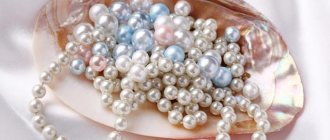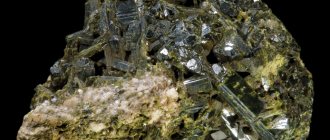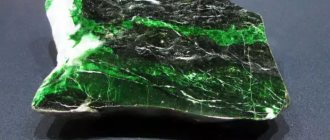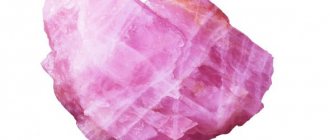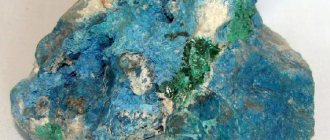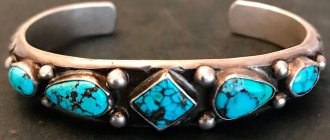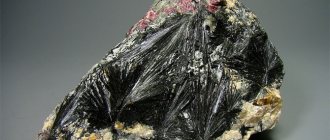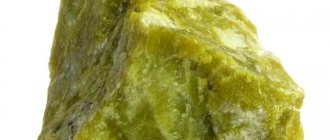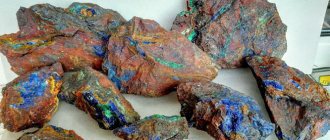- What: Ornamental;
- Deposits: USA, Burma, India, Central Asia, Australia, Africa, Siberia;
- Colors: Brown, burgundy, brown, purple, terracotta;
- Mohs hardness: 7;
- Transparency: Opaque;
- Density: 2.4-2.7 g/cm³;
- Formula: SiO2;
- Suitable person according to zodiac sign: Everyone;
- How much does it cost: from 90 rubles per bead.
Bull's eye stone, despite its cheapness, is one of the minerals endowed with unusually powerful energy, thanks to which it has provided magical and healing assistance to the population of our planet for many centuries.
Only people whose fortitude, will and perseverance are comparable to the similar qualities of the animal that gave the gem not only its name, but also limitless possibilities can enlist its support.
What is this stone?
Bull's eye, which is a type of “eye quartz”, or more precisely, a pseudomorph of iron and quartz oxides after crocidolite, according to mineralogists, is a decorative and semi-precious stone, tiger eye, exposed (artificial or natural) to high temperatures.
The result of this effect is partial dehydration of limonite, which is part of the original mineral, followed by its transition to hematite, which gives the stone a brown color.
The depth of the bull's eye in the earth's crust ranges from 500 m to 15 km.
The gem, which is of hydrothermal origin, is formed at a temperature of 300-500 degrees under pressure of up to 150 MPa.
Combustible gases released from magma chambers actively participate in this process.
Stone jewelry
Polished mineral is used for jewelry. The shape and edges are made with diamond-coated tools. Jewelers can change the color artificially. Heating the stone in a high temperature environment intensifies the natural shade or complements the red tone. Treatment with concentrated hydrochloric acid transforms it into the color characteristic of a cat's eye.
The stone is used in making:
- rings;
- bracelets;
- pendants;
- necklaces;
- beads;
- necklace;
- earrings
Jewelry with a bull's eye insert makes it light and heavy. Cannot be combined with precious stones in one look. Large gems are selected for evening wear. Small items are worn to work or for a walk. The mineral does not combine with translucent fabrics.
View this post on Instagram
Posted by Ruza Jasper (@ruza_mineral) Oct 3, 2021 at 2:40 PDT
View this post on Instagram
Posted by Vintage and Silver (@vintage_silver_kiev) May 24, 2019 at 3:07 PDT
View this post on Instagram
Posted by Author's Jewelry (@fatumgems) Mar 28, 2021 at 6:32 am PDT
Caring for stone and products
The bull's eye is cleaned with a damp cloth soaked in warm water. Can be washed with soap. The silver or gold frame is cleaned carefully, being careful not to apply the composition to the mineral. The moisture is blotted with a napkin and rubbed with suede.
Jewelry can be stored in a box with other jewelry. Talismans, amulets, and other esoteric artifacts are placed in a separate bag.
History of application
Different peoples have the following versions of the appearance of the mineral:
According to legend, an amulet with a gem was able to stop an angry bull rushing straight at its owner.
Noticing a magic stone on the man’s neck, the bull instantly lost its aggressiveness and stopped dead in its tracks, a few steps away from him.
Legend has it that the color of the stone exactly matched the color of a bull's eye.
In ancient Rome , the bull's eye, considered a powerful amulet, was used to decorate weapons, military armor and horse harnesses. With the help of the gem, Roman soldiers hoped to avoid death in battle.
Residents of ancient India used the gem to protect their homes from attacks by predators, placing piles of shiny nuggets in front of the entrance to their homes.
In addition, they were convinced that a stone that actively absorbs solar energy is able to generously share it with its owner.
It was customary to always keep the magic stone with you: it became noticeably heavier in the event of impending danger or illness, warning its owner about them.
Having the status of a sacred gem, the bull's eye - among other ritual accessories - participated in sacrificial rituals; jewelry with it was presented as a gift to the gods.
History of the Bull's Eye
— Advertising —
A wonderful unusual stone with a wet shine and gradient coloring, similar to a bull’s eye, has been known to mankind for a very long time. Warriors in ancient times made talismans from it, as they believed that the stone gave its owner strength and courage. In Ancient Rome, it was believed that the mineral was a reliable protector in battles and everyday life. Residents of India believe that the bull's eye is able to warn its owner of danger by becoming heavier. In addition, many cultures believed that this mineral absorbs solar energy and transfers it to people.
Both previously and now, bull's eye is widely used in jewelry. Decorative items and interior decorations are made from it.
Physical properties
Being a representative of the group of “eye” quartz, the bull’s eye has a characteristic vertical stripe running along the entire length of the crystal, which, after jewelry processing of the gem, acquires a resemblance to the pupil of an animal.
The stone (its chemical formula is SiO2) is characterized by:
- High hardness equal to (on the Mohs scale) 7 points.
- The presence of an uneven fine-fiber structure.
- Density equal to 2.4-2.7 g/cm3.
- Moderate silky shine.
- A splintered fracture.
- Lack of cleavage and transparency.
- White is the color of the line remaining on the surface of the porcelain biscuit.
- Heterogeneity of color, allowing the presence of dark and light stripes of different thicknesses. Primary colors: brown, intense crimson, red-brown. The unevenness of the background and the variety of colors are due to inclusions of other elements, and the iridescence is due to the presence of hematite in the chemical composition of the stone.
Properties and uses of bull's eye
The properties of the gem allow it to be used for jewelry, household items, and interior decoration. Often used in witchcraft, alternative medicine and magic.
A stone or jewelry is bought in the last phase of the moon, preferably on the 25th day, and begins to be worn after 12–14 days. This will give the bull's eye time to get used to the owner.
Physical properties
The gem consists of silicon oxide with hematite. Its chemical formula is SiO2. Bull's eye is difficult to break, but works well with a diamond tool. The mineral has a hardness of 7 on the Mohs scale and a density of up to 2.7 g/cm3.
When hit with a hammer, it breaks into at least two pieces. The plane of the split is splintered (hooked), fibrous. The color of the fracture is not uniform due to inclusions. After grinding, the fine powder will be white.
Healing properties
Beads, bracelets, and other products without minerals are suitable for healing. Healers say that through the bull's eye its owner draws the power of solar and earthly energy. This allows the body to reboot, which naturally normalizes metabolism, the functions of the glands and internal organs.
Wearing a bull's eye helps:
- recover from illness;
- lower blood pressure;
- get rid of smoking, alcoholism, pathological jealousy, and other addictions;
- eliminate acid-base imbalance;
- normalize the metabolic process in cells;
- restore the functions of the heart and bronchi;
- cure psoriasis and other chronic skin diseases;
- remove inflammation of soft tissues and joints;
- get rid of infertility.
The shimmer of the gem eliminates symptoms of depression and increases the threshold of stress resistance. In women, the stone accelerates recovery from gynecological infectious and inflammatory diseases.
To restore the healing power, the bull's eye is buried in the ground for a month or longer.
Learn more about the healing properties of the stone in the following video blog:
Magic properties
The gem is used in magic by esotericists, seers, bioenergetics, and mediums. This mineral gives strength, allows contact with a deceased person, connects time periods, and protects against the influence of sorcerers.
Astrologers attribute the bull's eye to the planet Mars. It is incompatible with stones of Mercury, Moon, Sun, Uranus, Jupiter.
The mineral is energetically “friendly” with the stones of Venus or Pluto:
- jasper;
- coil;
- rauchtopaz;
- amazonite;
- emerald;
- malachite;
- belomorite.
It is advisable to combine the bull's eye with silver and not combine it with other, even friendly, stones. This mineral is quite strong and suppresses or fights with the properties of other nuggets.
Bull's eye helps active, independent, purposeful people.
It protects warriors from death: a talisman of any color is kept near the heart and hung on the collar of clothing. Businessmen should wear jewelry with a red-colored gem on their left hand. The mineral attracts financial luck and entrepreneurial success, protects against scammers and unscrupulous partners.
Bull's eye is not allowed:
- wear continuously;
- store in the bedroom, recreation area;
- wear for extreme people, lazy, frivolous;
- use stone from previous owners;
- set in any metal (except silver).
The gem helps protect the house from ill-wishers, warns of danger, and attracts money. Protective amulets or talismans are made with the mineral. They are carried with them, hung on pets, and put in a wallet. The amulet for the home is left in a visible place in the hallway, living room, and in the office - on the desktop.
In moments of danger, the stone becomes heavier, tarnished or cracks.
Who is the stone suitable for according to their zodiac sign and name?
It is recommended to wear a bull's eye for men over 30 years old with the name Pavel. According to the horoscope, it suits Scorpios, these are the favorites of the mineral.
People with other zodiac signs or other names are also allowed to wear the stone. No one is incompatible.
For more information about the properties of the stone as a talisman, watch the video:
Varieties, colors
The heterogeneous gradient color of the bull's eye, as well as color shifts, are due to the presence of hematite in its chemical composition.
In nature, there are nuggets painted in different shades of the following colors:
- brown;
- burgundy;
- brown;
- purple;
- terracotta.
The color of the stone - depending on a number of factors (the presence of other trace elements, their percentage, exposure to chemicals and high temperatures) - can vary significantly.
The color of a natural mineral can be changed by:
- Heat treatment , during which the stone is exposed to high (up to 1000 degrees) temperatures. As a result, either the shade of the gem becomes reddish, or its natural color becomes more saturated.
- Treatment with concentrated hydrochloric acid , which gives the stone unusual brown and pastel shades, making it almost indistinguishable from a cat's eye.
Colors and varieties
The bull's eye is often confused with its relative, the tiger's eye. However, they have differences. Tiger stone always has a yellow-brown color. The color of the bull stone completely lacks yellow, and the predominant color is brownish-reddish.
The central element of the color is a dark stripe that “cuts” along the entire massif of the nugget. It is this that makes the mineral after processing look like a bull’s eye.
Bull's eye ring
The main color varieties of stone are as follows:
- Terracotta - reminiscent of red clay in shade.
- Brown - with transitions from light to dark.
- Brown - combined with cherry areas or chocolate stripes.
- Burgundy - different tones and shades.
- Purple - can be combined with brown, brown or red.
Magic properties
The magical properties of the bull's eye, used as a powerful magical artifact, help solve many problems:
- With the help of a gem that can bridge an intertemporal bridge connecting the present with the past, mediums come into contact with the souls of the dead. Hints received during such sessions allow you to either choose the most suitable option for an upcoming event, or radically change it.
- A bull's eye, lying in front of the front door or placed in the most visible place in the room (according to Feng Shui, this placement helps to better reveal the energy of the stone), will become an excellent amulet for the house, capable of protecting its inhabitants from the evil eye, damage and unkind people.
- A gem lying on the desktop will help its owner establish relationships with colleagues and defuse the situation in the office.
- For bankers, businessmen and financiers, the bull's eye will be an excellent talisman that should be kept with you during business negotiations and when signing important documents. If a dangerous situation for the owner arises (for example, in the event of concluding an unprofitable deal or concluding a contract with dishonest partners), the stone will become heavier, dim and lose its inherent shine.
- The magical power of the bull's eye will help anxious and fearful people more decisively achieve their goals.
Medicinal properties
The mineral, named after the bull, considered the standard of strength and health (this belief is reinforced by the saying: “healthy as an ox”), can help in the treatment of:
- Diseases of the genitourinary system (gynecological diseases, male and female infertility).
- Psycho-emotional disorders. Having saved its owner from excessive anxiety, depression, apathy and moral depression, the gem significantly improves his mental state. The positive vibrations of the stone improve the owner’s mood, charging him with optimism and positivity.
- Psychological addictions (drug addiction, alcoholism and smoking). Those who cannot get rid of addictions on their own are recommended to constantly wear an amulet with a bull's eye.
- Respiratory viral infections. The stone will not only relieve fever, but also help fight viruses.
- Problems with blood pressure. The help of bull's eye, which normalizes blood pressure, will be useful for patients suffering from hypo- and hypertension, as well as people complaining of its constant jumps.
- Dermatological diseases (for example, eczema, furunculosis and psoriasis).
- Lung diseases (bronchial asthma, tuberculosis, pneumonia). For such pathologies, lithotherapists recommend wearing a pendant with a gem at the level of the solar plexus.
Bull's eye can quickly restore the immunity of a patient who has undergone surgery or a serious chronic disease.
Regularly wearing a bull's eye will be useful for energy-depleted people: it will not only replenish their energy reserves, but also raise their overall vitality.
A gem used for medicinal purposes should not be placed in a metal frame, as it will completely neutralize its healing properties. An elastic bracelet, pendant or beads will cope with this task.
Who is suitable according to their zodiac sign?
According to astrologers, a gem that chooses its owner not by the stars, but by his personal qualities, will not only not harm, but will also be useful to representatives of all zodiac signs.
The astrological compatibility of the bull's eye can be considered ideal with people born under the sign of Scorpio , who are purposeful, powerful, energetic and strong individuals.
By multiplying the above qualities of Scorpios, the gem will protect them from damage and the evil eye, help them not to lose their presence of mind in stressful situations, and will also attract material well-being to them.
Aries , who have a tendency to take on all things at once and, as a result, fail to meet the assigned deadlines, with the help of a magical talisman, will learn to plan their activities, separating the most important goals from the secondary ones.
By enlisting the support of the bull's eye, loving and stubborn representatives of this sign will be able to tame their proud temperament, which will subsequently significantly simplify their lives.
Geminis, in difficult situations that require making a serious decision or activating their intuition, will be able to rely on the help of a talisman with a natural gem, which can become a reliable advisor for them.
The support of the stone, which is an ideal talisman for Taurus , will help them easily survive the most difficult trials of life.
The bull's eye will not only improve their health, but also help them gain energy, strength and a positive outlook on current events.
Cancers will be able to enlist the support of a bull's eye only if they are enterprising and energetic. The stone will direct the talents and energy of such individuals in the right direction, strengthening their desire to win and stimulating the need for self-improvement.
Slow and indecisive representatives of this sign are better off wearing a gem.
For Leos who hide their complexes and lack of self-confidence behind a bright mask of external success, the mineral will help them find their calling and realize their hidden creative potential.
Virgos can use the bull's eye as a strong amulet that can activate their intuition, which helps them sense the approach of danger and make the right decisions in time.
Sagittarius , who becomes the owner of a magical artifact, will be able to achieve harmony with himself and feel happy.
Capricorns , who are born leaders and careerists, who work hard on themselves and always achieve their goals, will be able to make their lives more harmonious with the help of a gem.
The stone will help them avoid nervous breakdowns caused by a busy work schedule.
Libra, who is always doubtful and slow to make a decision, under the influence of the gem, will gain insight and confidence in the correctness of the chosen path, which will significantly facilitate the process of conquering new heights.
The influence of the mineral will make the monotonous life of people born under the sign of Pisces more dynamic, and will also strengthen their will at the moment when, being one step away from achieving their goal, they are ready to give up.
For Aquarians , who are self-absorbed and known for their love of dramatizing far-fetched problems and their tendency to hysterics and despondency, a talisman with a bull's eye will help harmonize their inner world and find equanimity and calm.
Bull's eye and zodiac sign
Of all the zodiac signs, the bull's eye is best suited to Scorpio. However, it is important to pay attention to the character of the owner. The mineral becomes a good assistant to people who are purposeful, ambitious, hardworking, who are constantly in action and strive for new and new heights. The bull's eye will help such a person in all endeavors and contribute to maximum self-realization.
Who is the name suitable for?
An amulet with a bull's eye is ideal for a man named Paul. The energetic support of the gem will accompany him everywhere on the path to his cherished goal.
The stone will give Paul self-confidence, determination and willpower: qualities that he will need to overcome obstacles and difficulties.
Talismans and amulets
The bull's eye is an excellent talisman for a home or workplace.
Thanks to its ability to cleanse the surrounding space of negative energy, it harmonizes relationships between close relatives or work colleagues and wards off all kinds of misfortunes from them.
It should be remembered that under no circumstances should the bull's eye be stored in the bedroom.
It has been established that a gem can absorb the energy of a sleeping person, depriving him of his vitality.
That is why during sleep it is necessary to keep the stone in another room.
A mineral endowed with the ability to attract material well-being is often used as a money amulet (such a stone is given a round shape, making it resemble a coin).
When placed in an everyday bag or wallet (close to banknotes), it will help not only save, but also increase the cash you already have.
For careless people who easily relate to life's adversities and are not used to being upset about failures, it is better to refuse to wear an amulet with a bull's eye.
The energetically powerful mineral will soon begin to depress them and can cause severe fatigue.
An exception can be made only if serious problems arise, which can be dealt with with the help of a powerful amulet.
The “favorites” of the stone are independent, purposeful and active individuals.
Lazy people will never achieve his favor, so they often lose their amulets and amulets.
History and origin
The stone received its name for its resemblance to the eye of a bull. According to legend, the gem has an influence on this animal. The Romans and Hindus have a story where the mineral stopped an angry bull in front of its owner. The man miraculously escaped death from horns and hooves.
Bull's eye is considered a sacred mineral: the gem was used in rituals and ceremonies of India and the Roman Empire. It was left as a gift to the Gods, used during sacrifices, and made into amulets.
Scientists are divided on the origin of the stone. Some minerals are considered tiger's eye, which in its natural environment succumbed to hydrothermal influence. Due to heating, iron (hydroxides) is converted into hematite. Therefore, it acquires a reddish, brown tint.
According to another version, the gem belongs to eye quartz. Researchers claim that the mineral initially had its characteristics without the influence of temperature.
To watch a video of what a processed stone looks like:
Decorations
Bull's eye inserts are most often set in silver, medical or jewelry alloys, as well as in silver-plated cupronickel. Products framed with precious metals are made to order.
Jewelry with a bull's eye should be worn in compliance with the following rules:
- You can safely wear them anywhere: going for a walk, a friendly party or to the work office.
- It is highly undesirable to combine them with clothes made of dark fabrics and items with many transparent bright stones.
- Wearing jewelry and items with ox stone at the same time is considered a sign of bad taste.
- Jewelry with a bull's eye looks most organic on people who have crossed the thirty-year age mark. Children and teenagers will greatly benefit from a pendant or bracelet worn as a protective amulet.
Products and jewelry made from ox's eye
Bull's eye bracelet
Bull's eye jewelry is widely available and inexpensive. The stone is most often set with silver or jewelry alloys; gold items are less common.
Any metal extinguishes the healing properties of the bull's eye, since it has the best effect when touching human skin. Silver products with stones are talismans and amulets, gold ones are simply beautiful jewelry .
Today the approximate cost of a bull's eye is as follows:
- Beads – 0.16-1 dollar per piece.
- Tumbling – 1.5-3.5 dollars.
- Bracelet – 6-25 dollars.
- Designer bracelet with silver inserts – $65.
- Heart talisman – $11.
- Set of ring and earrings made of nickel silver alloy with large inserts – $55.
- Silver ring set + earrings with small inserts – $75.
- Necklace – 28 – 40 dollars.
- Silver ring – $22-50.
Care
Arm bracelet made of bull's, falcon's and tiger's eyes
Caring for the stone will not cause its owner any special difficulties or troubles:
- Bull's eye is not afraid of sudden temperature changes , so jewelry with it can be safely worn at any time of the year.
- Twice a month it is recommended to wipe the mineral with a piece of damp soft cloth (you can use clean water to wet the cloth). To remove heavy dirt, you can clean the stone with a brush and a solution of liquid soap.
- The hardness of the stone is such that when stored in the same box with other gems, there is no need to worry about its safety. More fragile stones may be damaged, so they should be placed in separate bags or wrapped in flannel.
Varieties and colors
The stone has a heterogeneous shade. It is for this reason that it is difficult to fake. Despite this, you can find pacifiers on the market, so you need to be extremely careful when purchasing.
The striping makes the mineral look like a tiger's eye. Two varieties of quartz have external characteristics that help distinguish them from other minerals.
Color palette of bull's eye found in nature:
- brown;
- terracotta;
- brown.
The bull's eye color can be changed in 2 ways:
- heat treatment. The influence of high temperature gives the mineral a red tint, and the natural glow becomes more intense;
- acid treatment. Concentrated hydrochloric acid gives the gem unusual shades. After chemical exposure, the bull's eye becomes similar to a cat's eye.
Although bull's eye and tiger's eye are similar in appearance, they can be differentiated from each other. Tiger's eye has the most brown and yellow colors, while bull's eye has brown coloring and no yellow stripes.
Ring with bull's eye stone
The shade of the gem depends on the composition of the stone. The predominance of one or another element is considered decisive in the formation of color.
How to distinguish from a fake?
Bull's eye - along with other types of eye quartz - is one of the inexpensive stones of which there are many on the market.
However, it is often counterfeited, offering fakes made of colored fiber glass or composite plastic under the guise of a natural gem.
In order to detect a fake, it is recommended:
- Pay attention to the weight of the stone by weighing it in your palm. A natural mineral is always heavier than glass and, even more so, plastic.
- Examine a pebble under the rays of the sun. Fake glass will cast too bright reflections that are not characteristic of natural stone; An unnaturally bright shine will give away a fake made of plastic.
- Use a hot needle , touching it to the test sample (of course, from the wrong side of the product). The plastic fake will melt, emitting a very pungent and unpleasant odor.
You can distinguish a natural gem from a synthetic fake with the help of an experienced gemologist with a well-equipped laboratory.
To avoid becoming the owner of a cheap fake, you need to buy jewelry in jewelry stores that have a good reputation.
What stones does it go with?
Combination with Amazonite
Combination with malachite
Combination with jasper
Bull's eye, which is a stone of Mars, is undesirable to combine with minerals of the Sun, Jupiter and Moon:
- diamond;
- coral;
- pearls;
- ruby;
- blue topaz;
- hyacinth;
- moonstone;
- amber;
- selenite;
- rock crystal;
- aventurine;
- sapphire;
- heliodor;
- turquoise;
- beryl;
- lapis lazuli.
Its proximity to the stones of Uranus and Mercury is equally undesirable:
- agate;
- labrador;
- amethyst;
- fire opal;
- peridot.
Bull's eye goes well with the minerals of Venus and Pluto:
- rauchtopaz;
- malachite;
- belomorite;
- amazonite;
- jasper;
- emerald.
Bull's eye and gems of this group have both aesthetic and energetic compatibility, so compositions from them are often used when assembling Shambhala bracelets, highly valued by people actively interested in esotericism.
Despite the friendliness of the patron planets, the owner of a bull's eye should remember that it is advisable not to combine this unusually independent and strong stone with other gems.
It will inevitably suppress the energy of weaker minerals, and with a nugget of equal strength it will come into conflict, which will negatively affect the condition of its owner.
When creating bracelets, beads and necklaces, bull's eye is combined with other representatives of "eye" quartz - cat's eye and tiger's eye.
Compatibility with other minerals
Bull's eye is a stone of the planet Mars. Considering the planetary “commonwealth”, the mineral does not like proximity to the stones of the Sun, Moon and Jupiter, including:
- Diamond;
- Ruby;
- Hyacinth;
- Amber;
- Aventurine;
- Heliodor;
- Coral;
- Moon rock;
- Beryl;
- Rhinestone;
- Pearl;
- Selenite;
- Lapis lazuli;
- Turquoise;
- Blue topaz;
- Sapphire.
Relations with the wards of Mercury and Uranus also do not work out:
- Agate;
- Amethyst;
- Chrysolite;
- Labrador;
- Fire opal.
Friendly planets for Mars are Pluto and Venus, which include the following minerals:
- Malachite;
- Amazonite;
- Emerald;
- Belomorit;
- Jasper;
- Rauchtopaz.
The friendliness of the patron planets is undoubtedly an important aspect. But it is worth remembering that bull's eye is a strong, independent mineral. It is recommended to wear this nugget separately from other stones, because it will suppress the energy of a weaker fellow, and “disagreements” will arise with a stone of similar strength, which will negatively affect the person’s condition.
Interesting Facts
The bull's eye, used to treat a serious illness, gives the patient all its positive energy, contributing to his speedy healing.
After the patient’s final recovery, the stone, which has absorbed an excessive amount of negative energy and has lost its strength, may “get sick” (tarnish or crack) and even “die”, crumbling into small pieces.
A “diseased” stone that has retained its integrity can be restored by burying it in the soil for a long time.
The process of restoring a gem that participated in the healing of a fatal illness can take several years.

